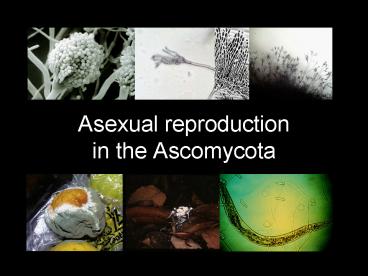Asexual reproduction in the Ascomycota - PowerPoint PPT Presentation
1 / 20
Title:
Asexual reproduction in the Ascomycota
Description:
aleuroconidia - thick-walled terminal conidium. functions as resting spore; aleurospores ... chlamydospore - thick-walled resting spore. usually produced from ... – PowerPoint PPT presentation
Number of Views:1027
Avg rating:3.0/5.0
Title: Asexual reproduction in the Ascomycota
1
Asexual reproductionin the Ascomycota
2
Anamorph mitotic reproductive stage
- the molds
- greater flexibility in growth
- propagation and colonization
- several generations of mitospores can be
produced in a - single growing season
- greater flexibility in dispersal
- dissemination of a species
- dispersed by wind, water, animals
- enhanced survival
- reproduction in the absence of opposite mating
type - resistant propagules
3
- Important structures in mitotic reproduction
- conidiophore - specialized hypha
- conidiogenous cell - spore producing cell
- conidium - mitospore
Penicillium
chain of conidia
conidiogenous cell
conidiophore
4
- Conidia
- Nonmotile, asexual propagules or spores
- dispersal by wind, water, insects
- septation and shape
dictyospore
amerospore
helicospore
didymospore
staurospore
phragmospore
images from 5th Kingdom www.mycolog.com/CHAP4a.h
tm
5
- Mitospores in reproduction and mycelium
establishment - spermatia
- minute spores that function as male gametes in
- spermatization can not germinate
- microconidia
- small conidia that can either germinate into a
- mycelium or function in spermatization
- macroconidia
- large conidia that typically only germinate into
a mycelium
6
Specialized conidia and mitotic propagules
aleuroconidia - thick-walled terminal conidium
functions as resting spore aleurospores
www.botany.utoronto.ca/ResearchLabs/MallochLab/Mal
loch/Moulds/Sepedonium.html
7
arthrospore - mitotic propagule produced by
hyphal fragmentation
www.mycolog.com/CHAP4a.htm
www.mycolog.com/CHAP4a.htm
8
chlamydospore - thick-walled resting spore
usually produced from somatic hyphae
9
- sclerotium
- resistant hyphal mass
- often darkly pigmented
- hard, tough texture
- germinate into mycelium or sporocarp
10
Conidiogenous cells (Fig. 8-9, 8-10) cell
from which a conidium is formed phialides -
conidiogenous cell with an open end through
which conidia develop in basipetal succession
Aspergillus
11
- Annelides
- conidiogenous cell that undergoes growth during
conidium - production
- elongated conidiogenous cell becomes marked by
scars - or rings
12
Conidiophores specialize hyphae that produces
conidiogenous cell may be simple hypha
produced off of somatic hyphae may be
elaborate complex hyphae that are comprised of
many hyphal segments or cell
Penicillium
Acremonium
simple conidiophore
branched conidiophore
13
Conidiomata - complex conidia bearing
structures coelomycetes - conidia produced in an
enclosed structure
Pycnidium
www.cals.ncsu.edu/course/pp318/profiles/deuteromyc
etes/deutero.htm
Acervulus
www.cals.ncsu.edu/course/pp318/profiles/deuteromyc
etes/deutero.htm
14
hyphomycetes - conidia produced on exposed hyphae
Synnema
www.mycolog.com/chapter11a.htm
www.cals.ncsu.edu/course/pp318/profiles/deuteromyc
etes/deutero.htm
www.mycolog.com/chapter11a.htm
www.cals.ncsu.edu/course/pp318/profiles/deuteromyc
etes/deutero.htm
Sporodochium
15
- Deuteromycota
- Coelomycetes - pycnidia, acervuli
- Hyphomycetes - synnemata, sporodochia, and
- simple compound conidiophores
- Mycelia sterila - no conidia production
- no longer accepted
- derived independently from numerous sexually
- reproductive lineages
- Loss of sexual reproduction
- has occurred repeatedly
- loss of mating type in population
- episodic selection of a genotype
- founder events
- hybridization
16
- Pleomorphy
- ability of a fungus to produce more than one
form or - type of spore in its life cycle
- Holomorph
- a fungus and all its expressions
- the totality of a fungal life cycle
- sterile mycelium and sexual and asexual
reproductive - states if they exist
- Holomorph Teleomorph Anamorph
17
- Teleomorphic holomorph - meiotic reproduction
only - Anamorphic holomorph - mitotic reproduction only
- Pleomorphic holomorph - meiotic and mitotic
reproduction, - or multiple anamorphs
- A holomorph can only have one teleomorph but can
have - none to several anamorphs
18
- Establishing teleomorph-anamorph connections
- establish pure culture from ascospore
- observe anamorph in culture
- establish pure culture from conidium
- observe teleomorph in culture
- molecular techniques
- molecular phylogenetic studies that compare
- relationships of teleomorphs and anamorphs
19
teleomorph
anamorph
holomorph?
NO!
Cordyceps militaris
Paecilomyces farinosus
holomorph YES!
Verticillium
20
P. farinosus
C. militaris































